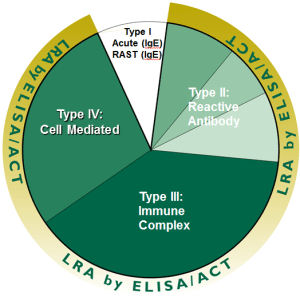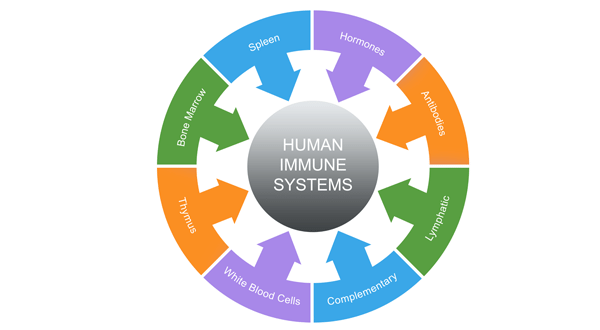Type 4 Hypersensitivity is often called delayed type hypersensitivity or a “delayed allergy” as the reaction takes two to three days to develop. Unlike the other types, Type 4 Hypersensitivity is not antibody mediated but rather is a type of cell-mediated response. CD4+ helper T cells recognize antigen in a complex with Class 2 major histocompatibility complex.
Today, at least one out of every six Americans, or 40 million people in the United States, suffer from one or more of the autoimmune and immune dysfunction diseases. In response, chronically ill Americans spend over $300 billion per year directly for autoimmune syndrome treatments that often do not reduce their suffering or improve their health. That’s why Russell M. Jaffe, MD, Ph.D., CCN, NACB developed the patented LRA (LRA by ELISA/ACT™) tests and treatment plan in 1984, enabling thousands of people to quickly and precisely determine the hidden causes of many chronic conditions.
Many of these hypersensitive delayed allergy reactions are caused and/or aggravated by foods and chemicals. Autoimmune and immune dysfunction illnesses include chronic nasal congestion, asthma, migraine headache, pain syndromes, weight management, personality changes, unexplained depression, thought disorders, and metabolically based m ood disorders.
ood disorders.
If you want to get tested to find out if you have Type 2, Type 3 or Type 4 Hypersensitivity, order your LRA ELISA/ACT test now. If you feel like you have Type 1 (immediate allergy), get tested here.
An Overview of Delayed Hypersensitivity
Identifying the rectants that cause these symptoms is not an easy task. Physicians often find it difficult to prove they are due to immune-medicated reactions, intestinal-enzyme deficiencies, toxins or infections, or even neurological/psychological reactions. Historically, physicians have attempted to determine the presence of “food allergies” with a few tools: a detailed allergy history, a physical examination, and laboratory tests (primarily intradermal injections and blood tests). While these procedures may indicate that the patient has allergies, they are of little help in identifying their causes. For example, an elevated blood serum lgE indicates a patient has acute allergies but does not identify the source of the program. The intradermal skin tests with commercial allergens used by traditional allergists are of limited value because of the larger number of false-positive reactions in normal persons.
None of the tests used by most allergists are of much help for delayed or hidden—Type 2, Type 3, and Type 4 Hypersensitivity. Delayed food and chemical hypersensitivities are caused by the immune system’s inappropriate response to ingested or inhaled foods or chemicals and their metabolic consequences. Although an antigenic substance may seem harmless, the white blood cells identify it as an intruder, even if it is a potential nutrient, and will attempt to fight it off. When the total load of foreign material is excessive or when the white cells are already weak, attempts to break down and neutralize this intruder can damage white cells. Once damaged, white cells excrete powerful, potentially damaging, reactive materials into the bloodstream. If enough reactive excretion occurs, the weaker organs or systems in the body are symptomatically affected.
The Immune System’s Role in Type 4 Hypersensitivity
One of the recent major advancements in medicine is our expanded understanding of the immune system and its important role in general health and wellness. Medical science has come to recognize that the immune system has defense as well as repair components. The defense component of the immune system fights off the foreign “invaders” that create disease, while the repair component restores tissue and organs from damage that the disease state may have caused.
If either the defense or repair function becomes overburdened or over-stressed, immune dysfunction and disease may result. Recent studies have shown that when the defense elements (lymphocytes) are mobilized against the effects of foreign antigens, the vital repair process is deferred. Organs and tissue weaken over time, and the body’s ability to fight off future assaults is reduced. The effect of immune system dysfunction can be chronic inflammatory and autoimmune diseases that often defy treatment.

Autoimmune Diseases
Autoimmunity means reflexive attack by the immune system on its host. Autoimmune conditions are characterized by lymphocytic, mononuclear cellular infiltrates in areas of active disease. Person-specific determinations of lymphocyte response assays (hsLRA) open a more advanced, comprehensive, functional, ex vivo system of tests.
Chronic autoimmune conditions are usually characterized by inflammation, focal or systemic swelling, pain, and cumulative repair deficit.
Examples of autoimmune conditions range from diabetes and Addison’s syndrome to thyroiditis and lupus (SLE), from eczema and psoriasis to allergic migraine headaches and multiple sclerosis, from asthma and pneumonitis to myocarditis and pericarditis, from rheumatoid arthritis to connective tissue syndromes, from glomerulonephritis to interstitial cystitis, from ulcerative colitis (UC) to regional enteritis (RE) to irritable bowel syndrome (IBS), from Sjogren’s syndrome to hepatitis, from uveitis to vasculitis, from myofascial pain syndromes to fibromyalgia (FM), from mitochondrial dysfunction syndrome (MDS) to chronic fatigue immune dysfunction syndrome (CFIDS).
ELISA/ACT’s Unique Testing Method
Compared to other types of lab tests, the hsLRA™ tests are the most comprehensive and specific tests in determining and addressing the hidden causes of many common health concerns.
LRA tests are…
Revolutionary blood tests that directly analyze lymphocytes, the body’s long lived, memory-carrying white blood cells that indicate health and disease in the body.
The only tests that simultaneously measure all three types of delayed sensitivity reactions through lymphocyte activation:
Reactive antibody (IgA, IgM, and IgG)
Immune complexes
T cell direct activation
The diagram to the right illustrates how LRA tests measure all three delayed allergy paths.
Ex vivo tests that analyze the lymphocytes’ response to foreign invaders under controlled laboratory conditions as they react in the bloodstream, providing highly accurate information about your delayed allergies.
Functional tests that detect only symptom-provoking lymphocyte reactions, not merely the presence and amount of antibodies (which can be protective or symptom-provoking). This distinction is clinically important and can only be made by a functional, cell response assay.
More reliable and comprehensive than other tests of delayed food and chemical sensitivities (Antibody, particle size, mediator release). Antibody tests such as IgG and IgG4 (offered by Cyrex, Immuno Labs, and many other labs) are nonfunctional tests, looking at only one delayed pathway – not a complete picture of the immune system. LRA tests also test the most items, as many as 504.
Click here for A Technical Overview of the LRA (also known as LRA by ELISA/ACT) Procedure
Who Can Benefit?
Clinical Successes
Over the last 30 years, and 10+ million cell cultures, the clinical benefits of hsLRA™ tests and treatment plans have been confirmed many times and in many patient types.
Learn how LRA has helped other patients.
Case Studies Outcome Studies Testimonials
The LRA by ELISA/ACT testing system is comprehensive and highly reproducible with a split sample daily variance of less than 3% of the items tested. This compares with 15-30% variance for other lymphocyte cell culture methods and 5-15% variance for older antibody procedures (like ELISA IgG / EIA).
For more information on Type 4 Hypersensitivity, click here.
If you would like to purchase a Type 4 Hypersensitivity or delayed allergy test, please visit Better Lab Tests Now.
Save

